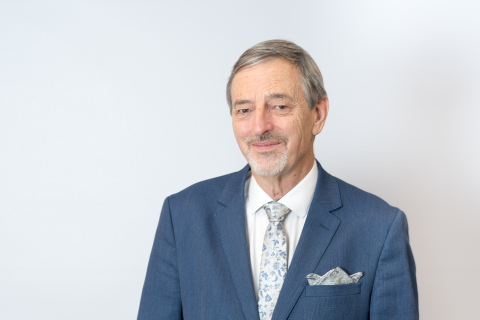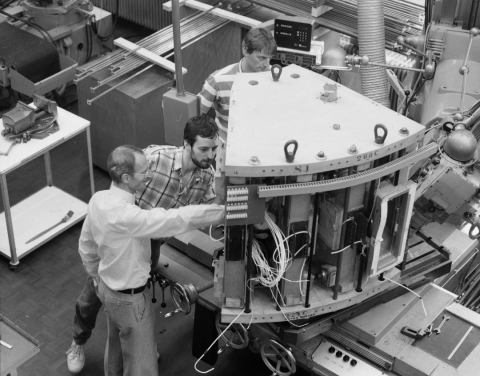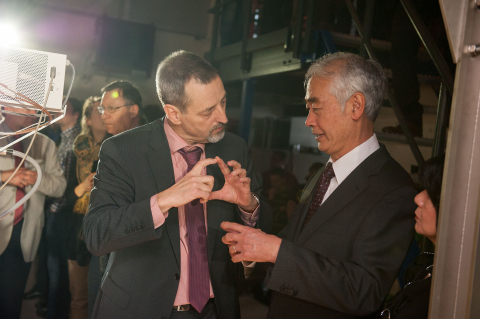Tony Donné has devoted his entire working life to fusion research. First in scientific roles in the Netherlands, and for the past nine years as head of the European research consortium EUROfusion. In December, Tony will take his leave and retire. We look back on his impressive career.

In 1980, you completed your degree in physics cum laude at the University of Utrecht and then obtained your PhD as a particle physicist at the Vrije Universiteit in Amsterdam. How did you end up in the world of fusion?
It was a bit of a coincidence. As a student, I had a broad interest, but I honestly found the lecture on plasma physics to be utterly boring! Particle and solid-state physics gripped me much more, and I went to work at Nikhef, the National Institute for Subatomic Physics. After my PhD, several options were on the table to work in America in 1985, but my heart turned out to be in the Netherlands.
A job became available at the Dutch centre for fusion research FOM Rijnhuizen in Nieuwegein. I had never been to the institute before and first wanted to know what the work entailed, what the people were like. I drove there on my wife's moped, for lack of a good bus connection. I can still see myself arriving there covered in mud. Working on a new measuring instrument insensitive to neutrons seemed interesting and there was a definite click.
From 1985 to 2014 you worked at FOM Rijnhuizen, renamed DIFFER in 2010. How do you look back on that time?
I was productive quickly, in the first year I already had four publications to my name. A year later I got a permanent job as head of the TORTUR tokamak group and a year after that as head of the diagnostics group (measuring instruments) for our new tokamak. That was the Rijnhuizen Tokamak Project (RTP), formerly the French tokamak Petula.
RTP ran for ten years and was scientifically one of my best times. We had a club of some 25 people in total—PhD students, permanent researchers and engineers—and many good ideas for advanced diagnostics that allowed us to look into what the plasma was doing in great detail. Many of our techniques were later adopted by other machines. You could say we were very progressive.
The atmosphere was also good. Once a month, we had a High Intensity Week. We worked double shifts, ate dinner together, worked through the night. And all in a great close-knit team. I think back to it with great pleasure.
By 2014, you had already been head of the fusion department within the institute for five years. What made you choose for a European position then?
I had a good time at the institute, which had just transformed itself into DIFFER. We had a good group of people who knew what we were going for. But something exciting was also happening in Europe. There, we were on the eve of a new way of working together, more strongly focused on a common research programme. All the national laboratories, like DIFFER, still had to get behind that. The question went around: 'Would you consider...?' I sent in my application two days before the deadline.

What was your leadership style on that international stage?
I have always worked very internationally with peers from Japan, India, America, Russia and other countries worldwide. And people know me as someone who makes connections. I like to listen to people and bring them together. That was undoubtedly another reason for asking me for this role.
I like to think back to the very first meeting of the General Assembly (GA) of EUROfusion. We had organised it in the Netherlands, at the Avifauna bird park. I lead the meeting, we had to elect a new chair for the GA, and it wasn’t going well. 'It's like that group of flamingos over there', I said to my neighbour: 'All looking in a different direction'. Then suddenly all the birds looked to the same side—someone was bringing in their food. We decided on the spot to take a food break as well and discuss with colleagues personally to get their beaks facing the same direction. That turned out to be a good basis for our proposal the next day.
Why is EUROfusion so important in your eyes?
EUROfusion coordinates all fusion research in Europe, and all the work that we co-finance thanks to European Commission funds must contribute to the central 'Roadmap' towards a fusion power plant. This avoids duplication of efforts, and it ensures that we can share researchers and facilities. Together, we figure out what research is needed, think about the best machine for it and send the most suitable people there. It works extremely well. Even countries without large-scale research machines can thus supply experts and contribute to the larger programme.
What challenges does fusion research currently face?
If we have the resources for it, I am convinced that as Europe we can realise fusion energy within the next 20 years. But then we will have to cooperate in a different way with each other and with industry. They are now mainly seen as contractors: researchers devise equipment and companies build it. Instead, you want industry to co-design.
Companies understand much better than scientists how to design a complex device like a fusion power plant so that the components can be manufactured efficiently and work together. That does require full reimbursement of industry costs, otherwise you won't get them on board.
Call it a Manhattan-like approach, highly coordinated so that we combine all efforts. Look at the fusion startups; there are now about 50 companies that each want to build their own design fusion reactor. These companies can move much faster and they can afford to make less conservative choices than public research. But they are not yet connected to the bigger picture.
The whole world on one fusion project?
Not necessarily, because healthy competition can also move things forward. Europe, America, China, Korea; many of the ITER members are now each designing their own demonstration fusion power plant. It has become a global competition, but international cooperation remains important for mutual benefit. At the same time, we want Europe to maintain its leading position in fusion research; we have the most thorough, realistic and comprehensive research programme. A 'go' from politics including sufficient funds, a quick choice of site and tight evaluation on progress. Bring it on!

Back to your own career. It has many highlights, but what really stands out?
That has to be the RTP period that I mentioned. Much more came out of that project than we had originally dared to hope for. We called it without exaggeration the best diagnosed tokamak in the world: nobody had so much measuring capability per cubic metre of plasma. I also found the EUROfusion time very exciting. It meant more distance from the day-to-day business of science, talking to politicians a lot and totally different challenges than I was used to.
What would you say to students considering a career in fusion?
Maybe this is old-fashioned, but don't just consult colleagues via email, whatsapp and video call. Sit at a table, have lunch together, talk to each other. You'll find yourself coming up with new ideas and unexpected connections. That is so enriching!
I love seeing young people enter the field, we need a new generation. There are huge challenges and great opportunities for fusion. What we need to pass on is, first of all, our knowledge, and I'm happy to commit to that in the coming years. But also the drive to realise fusion. Think of the Sagrada Familia cathedral in Barcelona. It took more than a century to build, but it is also nearing completion. There comes a time when it is finished, when fusion becomes a reality.
This article was written by Gieljan de Vries (EUROfusion) and Rianne van Hoek (DIFFER).
Bruggenbouwer Tony Donné kijkt terug op loopbaan als fusieonderzoeker
Zijn hele werkende leven heeft Tony Donné gewijd aan het fusieonderzoek. Eerst in wetenschappelijke rollen vanuit Nederland, nu al negen jaar als hoofd van het Europese onderzoeksconsortium EUROfusion. In december neemt Tony afscheid en gaat hij met pensioen. Een mooi moment om terug te blikken op een indrukwekkende loopbaan.
In 1980 rondde je de opleiding Natuurkunde cum laude af aan de Universiteit van Utrecht en daarna promoveerde je als deeltjesfysicus aan de Vrije Universiteit Amsterdam. Wat zorgde er voor dat je de fusiewereld in rolde?
Dat was stom toeval. Als student had ik een brede interesse, maar het college plasmafysica vond ik eerlijk gezegd oersaai! Kernfysica en vaste stof grepen me veel meer, en ik ging aan de slag bij Nikhef, het Nationaal instituut voor subatomaire fysica.
Na mijn promotie lagen er in 1985 meerdere opties op tafel om in Amerika te gaan werken, maar mijn hart bleek toch in Nederland te liggen. Bij het Nederlandse centrum voor fusieonderzoek FOM Rijnhuizen in Nieuwegein kwam een baan vrij. Ik was nog nooit bij dat instituut geweest en wilde eerst weten wat het werk inhield, hoe de mensen waren. Op het brommertje van mijn vrouw reed ik ernaartoe, bij gebrek aan een goede busverbinding. Ik zie mezelf er nog vies van de modder aankomen. Werken aan een nieuw meetinstrument dat ongevoelig is voor neutronen leek me interessant en er was een duidelijke klik.
Van 1985 tot 2014 heb je gewerkt bij FOM Rijnhuizen, sinds 2010 DIFFER. Hoe kijk je terug op die tijd?
Ik was snel productief, in het eerste jaar stonden er al vier publicaties op mijn naam. Een jaar later kreeg ik een vaste baan als hoofd van de TORTUR tokamak groep en een jaar later als hoofd van de diagnostiekgroep (meetinstrumenten) voor onze nieuwe tokamak. Dat was het Rijnhuizen Tokamak Project (RTP), voorheen de Franse tokamak Petula.
RTP heeft tien jaar gedraaid en was wetenschappelijk gezien een van mijn beste tijden. Met een club van in totaal zo’n 25 promovendi, vaste onderzoekers en ingenieurs, en veel goede ideeën voor geavanceerde diagnostieken waardoor we in detail konden kijken. Veel van onze technieken zijn later door andere machines overgenomen. Je kunt wel zeggen dat we heel vooruitstrevend waren.
Ook de sfeer was goed. Eens per maand hadden we een High Intensity Week. We draaiden dubbele shifts, aten samen, werkten ’s avonds. En dat in een geweldig hecht team. Ik denk er met veel plezier aan terug.
In 2014 was je van groepsleider alweer vijf jaar afdelingshoofd fusie binnen het instituut. Waarom ben je toen Europa ingegaan?
Ik had het op het instituut — toen net omgevormd tot DIFFER — goed naar mijn zin. Een goede groep mensen die wist waar we voor gingen. Maar in Europa gebeurde ook iets spannends. Daar stonden we aan de vooravond van een nieuwe manier van samenwerken, sterker gericht op een gemeenschappelijk onderzoeksprogramma. Daar moesten alle nationale laboratoria, zoals DIFFER, nog wel achter gaan staan. De vraag ging rond: ‘Zou jij niet eens …?’ Twee dagen voor de deadline heb ik mijn sollicitatie verstuurd.
Wat was jouw stijl van leidinggeven op dat internationale toneel?
Ik heb altijd heel internationaal samengewerkt met vakgenoten uit Japan, India, Amerika, Rusland en andere landen wereldwijd. En men kent me als iemand die verbindingen legt. Ik luister graag naar mensen en breng ze graag bij elkaar. Dat is ongetwijfeld ook een reden geweest om mij te vragen voor deze rol.
Ik denk graag terug aan de allereerste vergadering van de General Assembly (GA) van EUROfusion. Die hadden we georganiseerd in Nederland, bij vogelpark Avifauna. Ik zat de vergadering voor, we moesten een nieuwe voorzitter kiezen en dat liep niet. ‘Het is net als die groep flamingo’s daar', zei ik tegen mijn buurman: 'Alle kopjes een andere kant op’. Ineens keken al die vogels in dezelfde richting: de verzorger kwam net binnen met hun eten. We besloten ter plekke om ook een etenspauze in te lassen en bij collega’s langs te gaan om de snavels dezelfde kant op te krijgen. Dat bleek een goede basis voor ons voorstel de volgende dag.
Waarom is EUROfusion in jouw ogen zo belangrijk?
EUROfusion coördineert al het fusieonderzoek in Europa: al het werk dat wij meefinancieren dankzij fondsen van de Europese Commissie, moet bijdragen aan de centrale 'Roadmap' op weg naar een fusie-energiecentrale. Dat voorkomt dubbel werk, en zorgt er voor dat we onderzoekers en faciliteiten kunnen delen. Wij bedenken samen welk onderzoek er nodig is, denken na over de beste machine daarvoor en sturen daar de meest geschikte mensen naartoe. Dat werkt uitstekend. Ook landen zonder grootschalige onderzoeksmachines kunnen zo experts aanleveren en bijdragen aan ons programma.
Voor welke uitdagingen staat het fusieonderzoek op dit moment?
Als we de middelen er voor hebben, dan ben ik er van overtuigd dat we als Europa binnen nu en twintig jaar fusie-energie kunnen realiseren. Maar dan moeten we wel op een andere manier samenwerken met elkaar en met de industrie. Die worden nu vooral gezien als aannemers: onderzoekers bedenken apparatuur en bedrijven bouwen die. Je wil de industrie juist mee laten ontwerpen.
Bedrijven snappen veel beter dan wetenschappers hoe je een complex apparaat als een fusiecentrale ontwerpt zodat de onderdelen efficiënt maakbaar zijn en onderling samenwerken. Dat vraagt wel om volledige vergoeding van industriekosten, anders krijg je ze niet aan boord.
Noem het een Manhattan-achtige aanpak, sterk gecoördineerd zodat we alle inspanningen bundelen. Kijk naar de fusie-startups; er zijn nu ongeveer vijftig bedrijven die elk een eigen ontwerp fusiereactor willen bouwen. Deze bedrijven kunnen veel sneller schakelen en ze kunnen het zich permitteren om minder conservatieve keuzes te maken dan het publieke onderzoek. Maar ze haken nog niet aan bij het grotere geheel.
De hele wereld aan één fusieproject?
Niet per se, want gezonde competitie kan de boel ook vooruit helpen. Europa, Amerika, China, Korea; allerlei partijen in ITER ontwerpen nu hun eigen demonstratie-energiecentrale. Het is een wereldwijde wedstrijd geworden. Internationale samenwerking blijft belangrijk voor wederzijds voordeel. Tegelijkertijd willen we dat Europa onze leidende positie in het fusieonderzoek blijft houden; we hebben het meest grondige, realistische en alomvattende onderzoeksprogramma. Een ‘go’ vanuit de politiek inclusief voldoende fondsen, een snelle keuze voor een site en strakke evaluatie op de voortgang. Kom maar op!
Terug naar jouw eigen loopbaan. Die kent vele hoogtepunten, maar wat springt er écht uit?
Dat is toch wel de RTP-periode waar ik over vertelde. Er kwam veel meer uit dat project dan we oorspronkelijk durfden te hopen. We noemden de machine zonder overdrijven de best bemonsterde tokamak ter wereld: niemand had zoveel meetinstrumenten per kubieke meter plasma. Ook de EUROfusion-tijd vond ik heel spannend. Dat betekende meer afstand tot het dagelijks bedrijf van de wetenschap, veel met politici praten en totaal andere uitdagingen dan ik gewend was.
Wat zou je tegen studenten willen zeggen die een carrière in de fusiewereld overwegen?
Misschien ouderwets, maar overleg niet alleen via e-mail, whatsapp en een videogesprek. Ga met elkaar aan tafel zitten, lunch samen, praat met elkaar. Je komt dan ineens op nieuwe ideeën. Dat is zo verrijkend!
Ik vind het fantastisch om jonge mensen het veld in te zien komen, we hebben een nieuwe generatie nodig. Er zijn enorm veel uitdagingen en er liggen mooie kansen. Wat we door moeten geven is ten eerste onze kennis en daar zet ik me de komende jaren nog met plezier voor in. Maar ook de gedrevenheid om fusie te realiseren. Denk aan de Sagrada Familia. De bouw daarvan heeft meer dan een eeuw geduurd, maar die is ook bijna af. Er komt een moment dat het klaar is, dat fusie werkelijkheid wordt.
Dit artikel is geschreven door Gieljan de Vries (EUROfusion) en Rianne van Hoek (DIFFER).
Go to the News page.